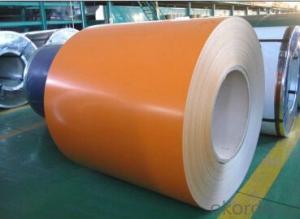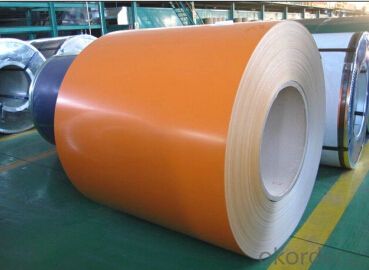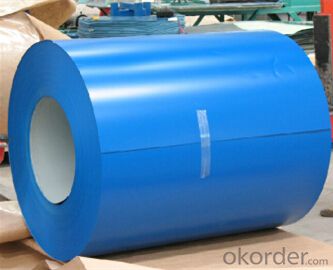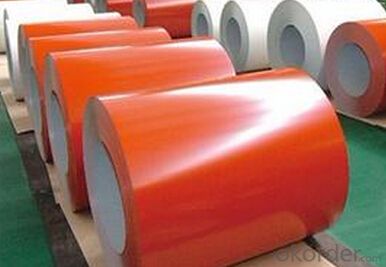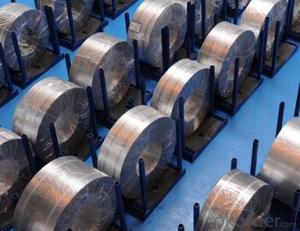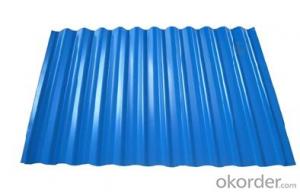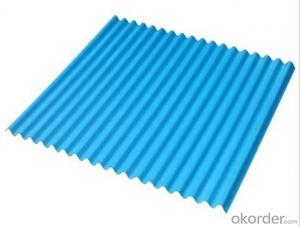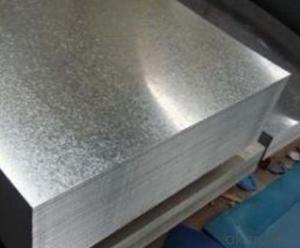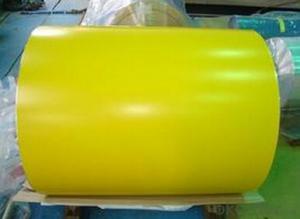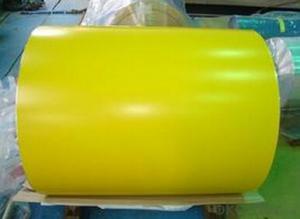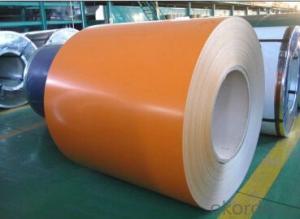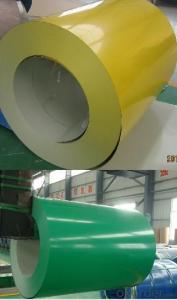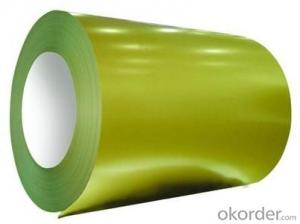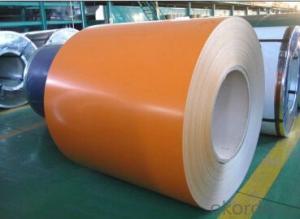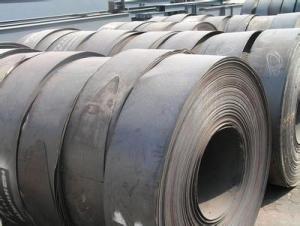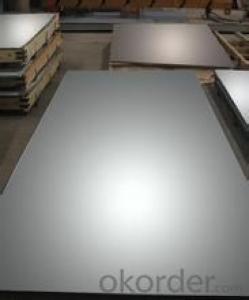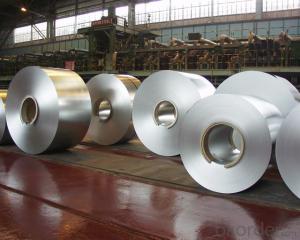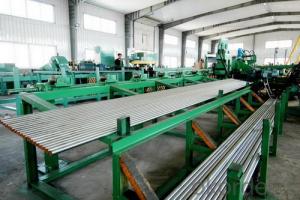PPGI Prepainted Galvanized steel Coil ASTM 615-009
- Loading Port:
- Tianjin
- Payment Terms:
- TT OR LC
- Min Order Qty:
- 22 kg/m²
- Supply Capability:
- 11 kg/m²/month
OKorder Service Pledge
OKorder Financial Service
You Might Also Like
1.Structure of Prepainted Galvanized steel Coil :
With Gi as base metal,after pretreatmet (degrease and chemical treatment) and liquid dope with several Layers of color,then after firing and cooling,finally the plate steel is called pre-painted galvanized steel ( PPGI) .Pre-painted galvanized steel is good capable of decoration ,molding,corrosion resistance lowering the cost of production and increasing the quality of the metal. Today, steel is one of the most common materials in the world, with more than 1.3 billion tons produced annually. It is a major component in buildings, infrastructure, tools, ships, automobiles, machines, appliances, and weapons. Modern steel is generally identified by various grades defined by assorted standards organizations.
2.Main Features of Prepainted Galvanized steel Coil:
• Excellent process capability
• Smooth and flat surface
• Workability, durability
• Excellent heat resistance performance
• High strength
• Good formability
• Good visual effect
3.Prepainted Galvanized steel Coil Images
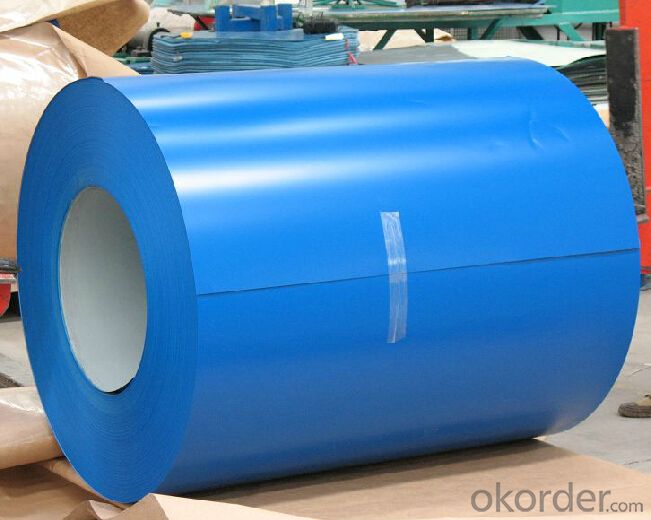
4.Prepainted Galvanized steel Coil Specification
Community portal – Bulletin board, projects, resources and activities covering a wide range of Wikipedia areas.
Help desk – Ask questions about using Wikipedia.
Local embassy – For Wikipedia-related communication in languages other than English.
Reference desk – Serving as virtual librarians, Wikipedia volunteers tackle your questions on a wide range of subjects.
Site news – Announcements, updates, articles and press releases on Wikipedia and the Wikimedia Foundation.
Village pump – For discussions about Wikipedia itself, including areas for technical issues and policies.
C | Si | Mn | Cr | Ni | P | S |
0.150 | 0.476 | 11.231 | 12.50 | 0.900 | 0.039 | 0.010
|
5.FAQ of Prepainted Galvanized steel Coi
We have organized several common questions for our clients,may help you sincerely:
1.How do you control your quality
We have established the international advanced quality management system,every link from raw material to final product we have strict quality test;We resolutely put an end to unqualified products flowing into the market. At the same time, we will provide necessary follow-up service assurance.
2.how long we will receive the goods ?
After receiving your deposit or workable lc ,our normal shipment date is 15-20days,and it takes around 28 days to reach your port of destination. But is up to different destination The bar-throated minla (Minla strigula) is a species of bird found in the montane forests of the Indian subcontinent and Southeast Asia.
3. what is your moq
Normally our moq is 25per size ,but it is up to different size
- Q: How are steel strips protected against extreme weather conditions?
- Steel strips are protected against extreme weather conditions through a combination of surface coatings and galvanization. Coatings such as paint or epoxy are applied to the steel surface to create a barrier against moisture, preventing rust and corrosion. Additionally, galvanization involves immersing the steel strips in a bath of molten zinc, creating a protective layer that further enhances resistance to harsh weather conditions.
- Q: What is the impact strength of a steel strip?
- The impact strength of a steel strip refers to its ability to withstand sudden, forceful impacts without fracturing or breaking. It is a measure of the strip's resistance to impact or shock loading.
- Q: What are the alternatives to steel strips for specific applications?
- There are several alternatives to steel strips for specific applications, depending on the specific requirements and characteristics needed for the application. Some of the alternatives include: 1. Aluminum Strips: Aluminum strips are lightweight, corrosion-resistant, and have good conductivity. They are commonly used in applications where weight is a concern, such as aerospace and automotive industries. 2. Copper Strips: Copper strips are known for their excellent electrical conductivity and high thermal conductivity. They are commonly used in electrical and electronics industries, where efficient electrical or heat transfer is required. 3. Plastic Strips: Plastic strips, such as PVC or polypropylene, are lightweight, cost-effective, and offer excellent corrosion resistance. They are often used in applications where non-conductivity, flexibility, or chemical resistance is important, such as in packaging, construction, or medical industries. 4. Fiberglass Strips: Fiberglass strips are lightweight, durable, and offer high tensile strength. They are commonly used in applications that require high strength combined with corrosion resistance, such as in marine, automotive, or construction industries. 5. Carbon Fiber Strips: Carbon fiber strips are lightweight, high-strength alternatives to steel. They offer excellent tensile strength and are commonly used in applications that require strength combined with low weight, such as in aerospace, sporting goods, or automotive industries. 6. Titanium Strips: Titanium strips are lightweight, corrosion-resistant, and possess high strength-to-weight ratio. They are commonly used in applications that require high strength, corrosion resistance, and low weight, such as in aerospace, marine, or medical industries. 7. Composite Strips: Composite strips, made from a combination of materials such as fiberglass, carbon fiber, or aramid fibers, offer a combination of different properties. They are used in applications that require specific characteristics, such as high strength, low weight, or specific thermal or electrical properties. It is important to carefully consider the specific requirements and characteristics needed for the application before selecting an alternative to steel strips. Each alternative material has its own advantages and limitations, and the choice will depend on factors such as cost, weight, strength, corrosion resistance, and other specific needs of the application.
- Q: How are steel strips used in the manufacturing of lighting fixtures?
- Steel strips are used in the manufacturing of lighting fixtures to provide structural support and stability to the fixtures, as well as to form the base or frame of the fixture. The steel strips are often shaped, bent, or welded to create the desired design and shape of the lighting fixture.
- Q: What are the environmental impacts of steel strip manufacturing?
- The environmental impacts of steel strip manufacturing include air pollution from emissions of carbon dioxide, sulfur dioxide, and nitrogen oxide, which contribute to climate change and air quality degradation. Additionally, the manufacturing process consumes significant amounts of water and energy, contributing to water scarcity and increased greenhouse gas emissions. Steel strip manufacturing also generates solid waste, such as slag and scale, which can contaminate soil and water if not properly managed. Overall, it is essential to implement sustainable practices and technologies to minimize these environmental impacts and promote a more eco-friendly steel strip manufacturing industry.
- Q: Can steel strips be used in food processing applications?
- Yes, steel strips can be used in food processing applications. Steel strips are commonly used in food processing equipment, such as conveyors, cutting blades, and packaging machinery, due to their strength, durability, and resistance to corrosion. Additionally, steel strips can be easily cleaned and sanitized, making them suitable for maintaining high hygienic standards in food processing environments.
- Q: What are steel strips made of?
- Steel strips are typically made of carbon steel, which is an alloy of iron and carbon. The carbon content in the steel strips can vary, depending on the desired properties and end-use applications. Other elements such as manganese, silicon, and sulfur may also be added to enhance specific characteristics of the steel. The steel is typically melted and then cast into long rectangular shapes called billets. These billets are then hot-rolled through a series of rolling mills to gradually reduce their thickness and form them into long, thin strips. The resulting steel strips have excellent strength, durability, and versatility, making them suitable for various industries including automotive, construction, manufacturing, and more.
- Q: How are steel strips packaged for shipping?
- Steel strips are typically packaged in a manner that guarantees protection and allows for easy handling during shipping. The packaging process begins by tightly coiling the steel strips into rolls. These rolls are then enveloped with a layer of protective material, such as plastic or paper, to prevent any harm or scratches while in transit. To further secure the rolls, it is common to place them on wooden pallets or steel skids, which provide stability and facilitate handling. Strapping or bands are often utilized to fasten the rolls to the pallets or skids, preventing any movement or shifting during transportation. Once the rolls are securely fastened, they are either placed in shipping containers or loaded onto trucks or flatbeds for transportation. The selection of containers or trucks is based on the dimensions and weight of the steel strips, ensuring a safe and efficient journey. In certain instances, steel strips may be packaged in bundles rather than coils. Bundles are formed by stacking multiple strips and securing them with bands or wire ties. These bundles are then wrapped with protective material and placed on pallets for shipping. Overall, the packaging of steel strips for shipping is meticulously carried out to guarantee their safety and minimize potential damage during transportation, enabling them to arrive at their destination in optimal condition.
- Q: What are the temperature limits for steel strips?
- The temperature limits for steel strips can vary depending on the specific grade of steel, but generally, they can withstand temperatures ranging from -50°C to 1200°C.
- Q: Are steel strips suitable for making utensils?
- Yes, steel strips are suitable for making utensils. Steel is a durable and strong material that can withstand high temperatures and resist corrosion. It is commonly used in the production of kitchen utensils due to its versatility and ability to be easily shaped and molded into various forms.
Send your message to us
PPGI Prepainted Galvanized steel Coil ASTM 615-009
- Loading Port:
- Tianjin
- Payment Terms:
- TT OR LC
- Min Order Qty:
- 22 kg/m²
- Supply Capability:
- 11 kg/m²/month
OKorder Service Pledge
OKorder Financial Service
Similar products
Hot products
Hot Searches
Related keywords
